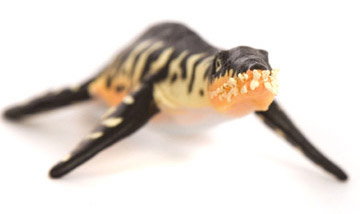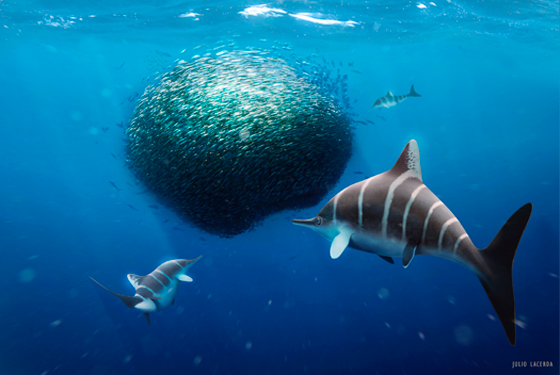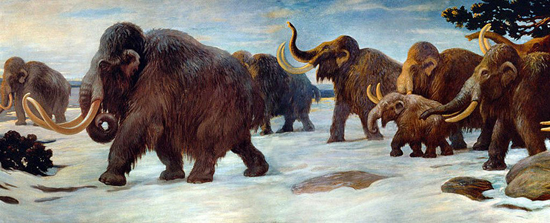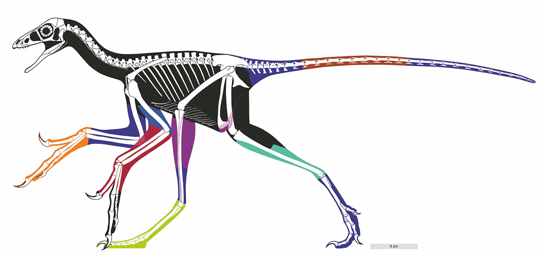Debate still continues over the maximum size of this Pliosaur
Ever since Liopleurodon featured in episode 3 of the ground-breaking BBC series “Walking with..” this short-necked plesiosaur, more commonly referred to as a pliosaur has been regarded as a truly huge predator. The programme showed Liopleurodon snatching an unwary Eustreptospondylus from rocks and chomping female pphthalmosaurs in half before finally coming to a sad end stranded on a Jurassic beach. Just how big was Liopleurodon?
At the time the writers and researchers for the TV series estimated that an adult male Liopleurodon could reach lengths in excess of 25 metres and weigh more than 150 tonnes. If this were indeed the case then Liopleurodon with its 18 inch long teeth could lay claim to being the biggest carnivorous animal ever.
Fossil Discoveries Do Not Back Claims
However, the existing fossil evidence does not back up the BBC’s claims. There are four species of Liopleurodon known, the first and the holotype for the Liopleurodon genus (L. ferox) was named and described by the French palaeontologist, H. E. Sauvage in 1873. Sauvage was working with very poor material, basing his scientific description on some smooth-sided teeth found in France. This is how Liopleurodon got its name (means smooth-sided tooth). These remains are dated to the Callovian stage of the Jurassic, other Callovian remains ascribed to Liopleurodon have been found in France and England, over the years much more evidence has been unearthed but reconstructions, if correct only put L. ferox at about 10 metres long.
How Big Was Liopleurodon?
The Oxford museum has a partial mandible believed to be from another Liopleurodon (L. macromerus). This measures over 2.8 metres in length, but the mandible is not complete. Estimates of over 3 metres have been given for the full length of the jaws, this could indicate that this individual was considerably bigger than L. ferox. Liopleurodon macromerus is also known from Jurassic deposits close to the river Volga in Russia.

The fearsome Liopleurodon. The CollectA Age of Dinosaurs Liopleurodon model, A fantastic replica of a Jurassic pliosaur.
This area yields a number of marine reptile fossils each year, to read an article on a recent pliosaur find: Russian Scientists unearth Pliosaur remains.
Other fragmentary pliosaur remains indicate that individuals may have grown to lengths in excess of 18 metres, but these cannot be ascribed with certainty to the Liopleurodon taxon.
Huge Pliosaur from Mexico
In 2002, a joint German/Mexican expedition announced the discovery of a huge pliosaur in Mexico. The animal was estimated to be at least 15 metres long, and probably a not yet fully mature adult, so this reptile still had some growing to do! This creature was nicknamed “the monster of Aramberri” after the location of the fossil find. The remains showed evidence of predation so perhaps an even bigger pliosaur had killed this relative youngster. At the time, this fossil (the best preserved bits were some articulated vertebrae), was described in newspapers as being a Liopleurodon, although these remains have not been placed within any pliosaur genera. The rostrum with some teeth were also found but since this discovery in 1985 and its pronouncement in 2002, this element of the specimen has been lost. Ironically, the research team excavating the fossil reported cutting themselves on the ancient teeth, as they were so sharp.
The sediments from which this fossil was recovered date from the Kimmeridgian stage of the Jurassic, a much later stage than the Callovian. This has led palaeontologists to speculate that this specimen does not belong to the Liopleurodon group.
Until further fossils are found it looks the speculation on the size of Liopleurodon is set to continue.
The inspiration for the scene in episode 3 of “Walking with..” when the Liopleurodon snatches the Eustreptospondylus from rocks came from another BBC documentary team, who had filmed Killer Whales risking beaching as they pursued young sea lions.
To view Everything Dinosaur’s range of prehistoric animal models including Liopleurodon models: Models of Marine Reptiles including Liopleurodon.






i love dinosaures but some of them are just mean! 😉
In that walking with dinosaurs episode they did say that the male liopleurodon was over 100 years old and was big even for his kind
Hi Alan,
The estimates for Liopleurodon genera have been considerably scaled down over the last ten years or so. As we say, it has been subjected to a “palaeontologist’s shrinking ray”. Although these creatures continued to grow all their lives and very probably lived for many, many years, it is unlikely, given the current fossil evidence that Liopleurodon reached the size claimed in the “Walking with Dinosaurs” programmes.
Hi Alan, I think that liopleurodon was big. Like super big! Given the chance to live and die a natural death the length of a full grown liopleurodon would be massive.
Umm you are wrong
Hi. Do we know what family/genera the mexican speciman is? How it may rlate to the other extinct marine reptiles? Have any others been found?
The “Monster of Aramberri” as it is known is one of a number of very large Pliosaur fossils that have been unearthed in recent years. The fossil is very fragmentary, part of the original material (rostrum) has been lost and like a lot of other large Pliosaur fossils very few academic papers, peer-reviewed papers, have been published. It has been estimated to be around 15-18 metres long. As far as we know, it has not been assigned to any specific genera but it is very likely not a Liopleurodon. With palaeontology there is always a lot of interest in the “biggest Pliosaur in the world”, this specimen is rivalled by the Svalbard fossils (at least two individuals) and the Pliosaur specimen with partial jawbones found in Dorset (England). Search for further Pliosaur related articles on the Everything Dinosaur blog for more information.
Thankyou very much.
Liopleurodon probley grew up to53merters long just it is hard to find a fossil like that cause it could be deep under growd
Actually, no. If it was deep under ground, it would be from an earlier age,but if you dug in different places, mabye you could find larger Liopleurodons. And where did the 53 metres come from?
dude do you know how big a meter is XD 53 meters is like 160 feet XD
Lyplaurodon is easily210 merters I dreamed it it must be true ohhh and the original jellyfish the man of war will take over the world they are coming for you someday the Jellys will rise against mankind and make us live in the oceans they are a coming…………..
Liopleurodon was definitely larger than the average mosasaur , I mean it hunted mosasaur an we all know that . If it were to hunt one of the largest predators in the sea that can grow up to 50 meters long , than Liopleurodon had to have been bigger than a meager 12 meters ! Lio was humongous , most likely one of the biggest predators alive , don’t listen to naysayers just because the mainstream archeological community has yet to figure out the biggest fossils they know about truly are a lost genus of Liopleurodon (there are many undiscovered I’m sure, and at least three already unearthed).
Wow you guys are amazing!
what do u mean they are amazing?
wow does anyone understand how big a meter is? I know its boring but the biggest creature of all time lives now. its a blue whale it can max out at about 30 meters. 50 plus meters some of you say ffs! yous must be 12 or younger. there would not be enough food for it to eat. and to answer an earlier post a mosasaurus is exaggerated a lot in terms of size in jurrasic world it actually only grows to about 3-4 meters long! so not only is liopleurodon from a different time scale so it would not eat a mosasarus but the fact its not that big means its nothing to brag about. I hope one day theres proof a lipleurodon could grow too 25 and its skull alone 5 meters. simply because I grew up believing that! truth is just like the mosasarus li is a lot smaller probs between 6-10 meters
i have a theory. what if liopleurodons exhibited extreme sexual dimorphism like anglerfish? the males would be 10 meters, but perhaps the females might have grown to 18+ meters. that way everyone is happy.
could you guys stop arguing ????!!!! plus it’s spelt Liopleurodon not Lyplaurodon and it is 15 m long ok?
Blurchbot-thats not a theory, it’s a hypothesis.
Delbomber there could be huge undiscovered creatures that a 50m Liopleurodon could survive on eating
people can’t find everything because Liopleurodon lived in Europe around the area in between England France and what before ww1 was Germany and in that area is the English Channel and people can’t start an archeological dig at the bottom of the English Channel
The fact we know for a fact they found a skull that measures 5 metres long!!! Tells me it’s got to be bigger then 10 metres! 25 is a bit of a stretch 16-20? I am happy to believe that
One last thing they have discovered fossils of animals as small as your finger! If something was 50m big they would of found it by now! Don’t say it might live in the deep sea! ???? there is simply not enough food to feed any animal that size down in the deep
Don’t believe it Delbomber. Theres 25m squid and 20m carnivorous whales (sperm) and then there might be Meg still hanging around down there
honestly i don’t think it would live down there or something because majority of things that live in the deep have weird things that make them light up like a christmas tree, in other words they got lights to see and survive(remember i said majority not all have lights). i mean its possible that its carcass sunk to the deep for all deep sea scavengers to eat but its just a possibility
I have never heard so much unsupported speculatory claptrap based on nothing other than ‘I would like it to be this big’! Evidence is far from conclusive in any direction and until more examples come to light the true size range will remain undetermined (but come on! 210 metres? That’s over a fifth of a kilometre!!!)
I think we are not really sure yet it could have grown to 25m but that does seem a bit unrealistic, it was probably bigger then 10m though, from the evedance of a 5m skull then it would be a least 15-20m, and who knows, a 25m specimen could have existed?
i’ve spent years trying to find out if my favourite marine reptile is 25 metres or not, but i don’t think that it would be like 1-8 metres or something, i honestly think that there is not enough fossils, there is like 4, and i think that those ones were young and even if the monster of aramberri isn’t a liopleurodon(even though i think it is) what the hell killed it. i would say the size would be at least 15-18 of a full grown adult. either way i am gonna keep believing but try not to be unrealistic about it